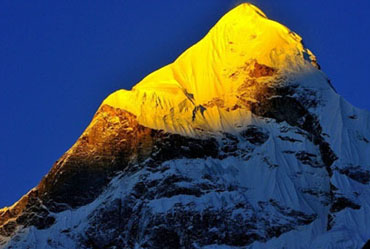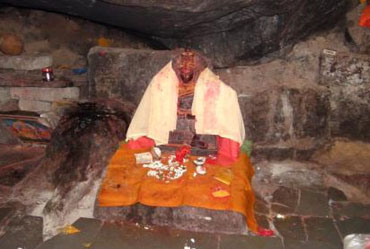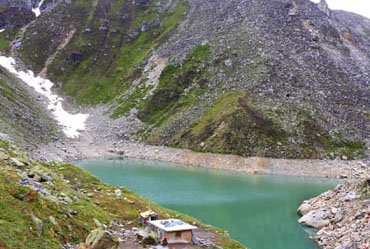If you are visiting Badrinath and looking for additional spiritual sightseeing, there are several remarkable places of religious and tourist significance nearby. The region is rich in natural beauty and cultural heritage, offering visitors a chance to explore serene landscapes & connect with the divine.
You can immerse yourself in the tranquil surroundings, take part in local traditions, and experience the area's vibrant spirituality. Each site nearby adds depth to your journey, making your visit to Badrinath even more enriching and memorable.

Originating from the Nar Narayan Peak of Himalayas at 400 ft, Vasundhara Falls is a waterfall located in Mana Village, 9km from Badrinath. The fall meets with the Alaknanda river at an altitude of 12,000 feet. It is believed to have been the resting place of the Pandavas. People also believe that the waterfalls turn away from visitors impure in thoughts and heart.
Vasundhra Falls can be reached by trekking for 6km. The first 3km from Badrinath to Mana Village is a motorable road and can be reached by taxi while the remaining 6km is a walkable trek of around 2 hours. The trek becomes little difficult after passing Saraswati Mandir in the Mana Village. The views of the Vasundhara River Valley during the trek is breathtaking.

Nilkanta is a major peak in the Garhwal division of the Uttarkhandi Himalayas. At a height of 6507 masl, it is one of the most important and religiously revered peaks of the region due to its close proximity to Badrinath. It overlooks the lovely valley of the Alaknanda River.
The snow-covered peak rises dramatically against the background of the crisp blue sky and presents one of the most beautiful sights that the region had to offer. Neelkanth lies in the midst of a medley of glaciers. The Satopanth Glacier lies on the northwest side of Nilkantha, while the Panpatia Glacier lies to the southwest, and feeds the Khirao Ganga, a stream running under the south of the peak.

Believed to be the home of Lord Agni, Tapt Kund is a natural hot water spring near the Badrinath Temple, heating to 45 degrees Celsius. Located by the Alaknanda riverbank, visitors take therapeutic baths here. The water of the kund is believed to have medicinal properties, curing various skin diseases. Devotees take a dip in the Tapt Kund before visiting Badrinath Temple.
Known to purify the soul, pilgrims flock to this Kund to relieve themselves of their sins, known as the Agni Teerth. Mythologically believed to have originated from Lord Shiva's Kapala (Head), the Kund's thermal energy is said to be much greater than most water bodies. The bathing area has separate arrangements for men and women.

Mana Village hosts the famous Bheem Pul situated opposite the Vyas Gufa near Badrinath. It is a natural stone bridge across the mighty Saraswati River. Located in the mythical Badrinath, Bheem Pul has a legend associated with it. It is believed that the Pandavas of Mahabharata started their Swargarohini from this village.
Between the two mountains, flowed the River Saraswati with full force and joined the River Alaknanda. One of the five Pandavas, Bheem threw a large rock to join the mountains so that Draupadi could walk over it easily. This is where the rock gets its name. A river raging with tremendous force and bubbling water, the natural rock bridge and the surrounding caves make for a stunning spectacle.

Vyas Gufa is believed to be the place where sage Vyas composed the Mahabharata epic with the help of Lord Ganesha. He also composed 18 Puranas, Brahma Sutras and four Vedas. Maharishi Vyas statue is installed in the caves and worshiped by the pilgrims. A distinct feature of the temple is the roof which resembles the pages from the collection of his holy scripts.
There is also an interesting story related to the place that explains the broken tusk of Lord Ganesh. When Vyas was composing Mahabharata, he needed someone to take down his dictation and asked the learned Ganesha for the same. Ganesh agreed but he had a condition - that Vyas would not stop even for a moment or else he would stop writing and leave.

Mana Village is inhabited by Indo-Mongolian tribes known as Bhotias. The village has about 180 households and a population of about 600. The villagers are culturally associated with activities of Badrinath temple and annual fair of Matha Murthi. They perform an annual traditional act by offering a choli to the deity on the closing day of the temple.
Mana village has several caves including Vyas Cave. It is said that Veda Vyas dictated his famous Mahabharata to Lord Ganesh here. One more cave is called Ganesh Gufa near Vyas Cave. There is a natural rock that rests over the river known as Bhim Pul. Legend says that Bhima, one of the five Pandavas placed the rock to make way Draupadi to cross the river during their Swargarohana.

Satopanth is a triangular lake with three corners spread within the circumference of about a kilometer. The lake is surrounded by snow covered peaks and is named after the Hindu gods Mahesh, Vishnu and Brahma. It is believed that the divine Trinity of Brahma, Vishnu and Mahesh had meditated here and each corner of the triangular lake is named after them.
The lake is considered to be of religious significance to the local people. There is a saint known as Moni Baba, who stopped talking several years ago. There is a common belief that he can live only on sun and air, if food is unavailable. Also some unique birds are found here, which pick up the pollutants of the lake and thus keep the lake clean.